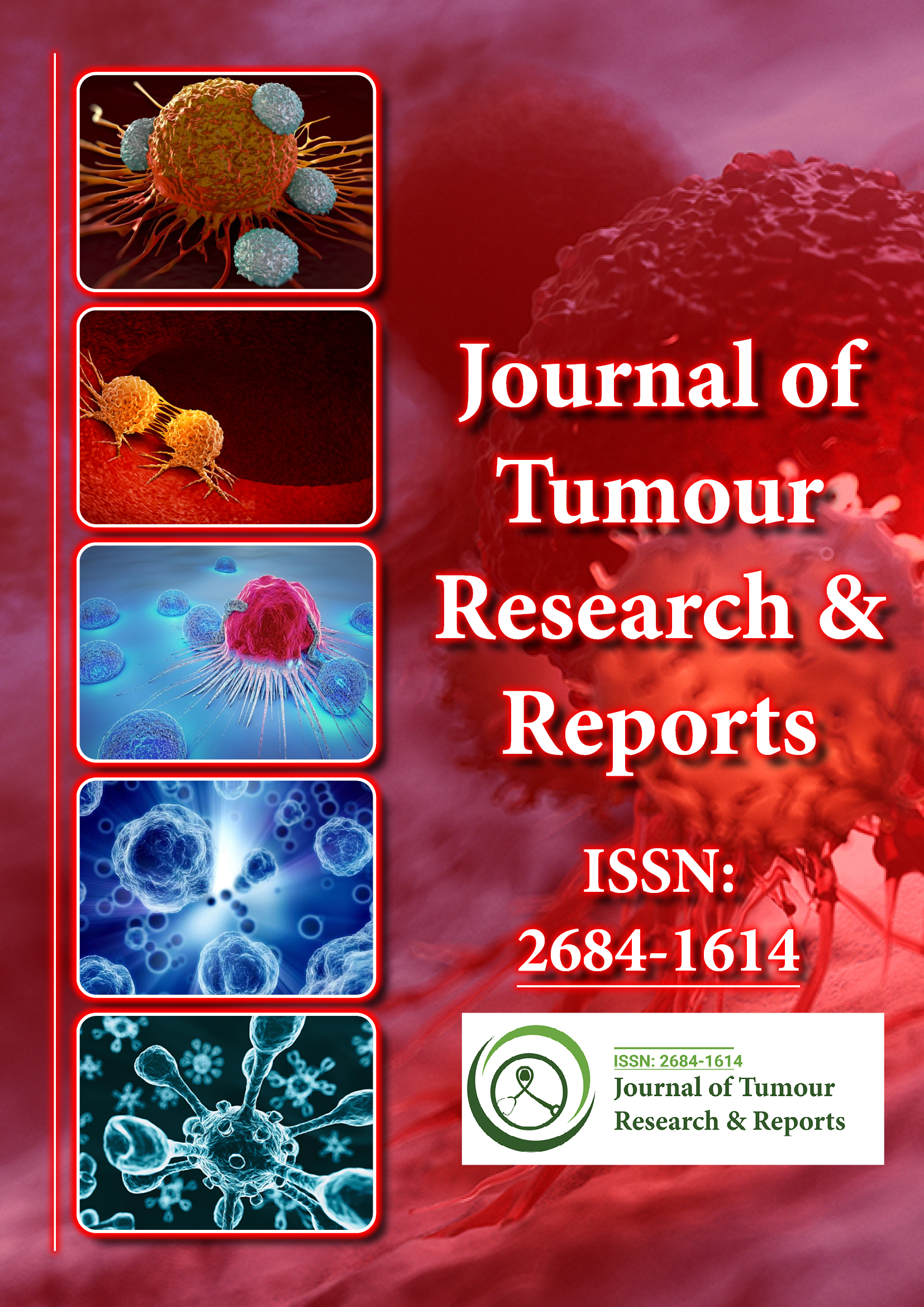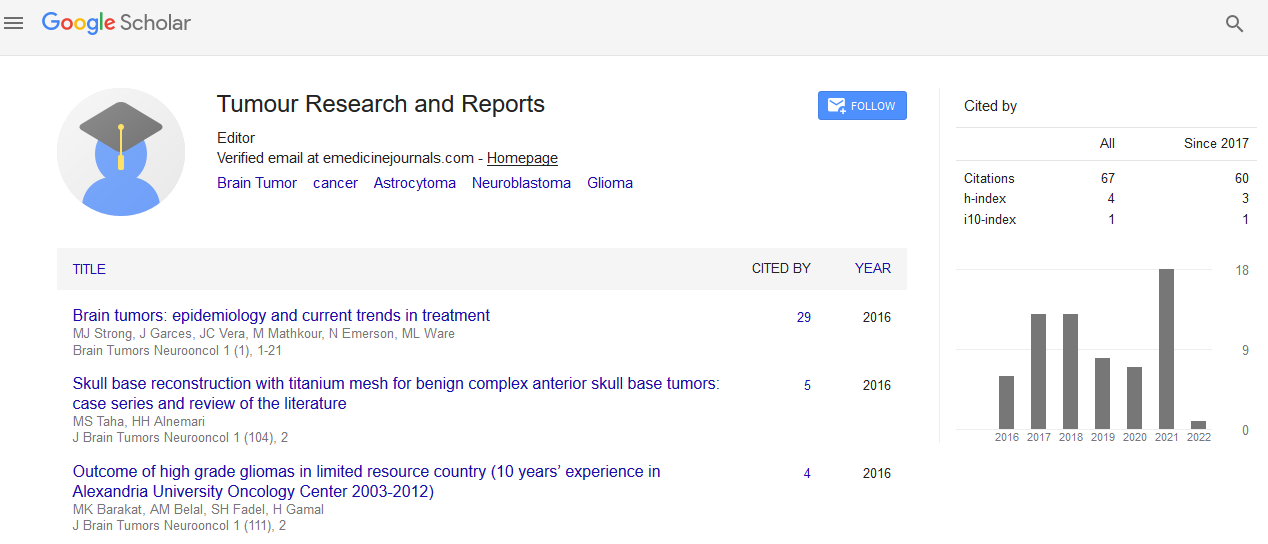Indexed In
- RefSeek
- Hamdard University
- EBSCO A-Z
- Google Scholar
Useful Links
Share This Page
Journal Flyer

Open Access Journals
- Agri and Aquaculture
- Biochemistry
- Bioinformatics & Systems Biology
- Business & Management
- Chemistry
- Clinical Sciences
- Engineering
- Food & Nutrition
- General Science
- Genetics & Molecular Biology
- Immunology & Microbiology
- Medical Sciences
- Neuroscience & Psychology
- Nursing & Health Care
- Pharmaceutical Sciences
Commentary - (2025) Volume 10, Issue 1
Nanoparticle-Based Drug Delivery Systems in Glioblastoma: Revolutionizing Targeted Therapy
Anaya Souza*Received: 03-Mar-2025, Manuscript No. JTRR-25-29015; Editor assigned: 05-Mar-2025, Pre QC No. JTRR-25-29015 (PQ); Reviewed: 19-Mar-2025, QC No. JTRR-25-29015; Revised: 26-Mar-2025, Manuscript No. JTRR-25-29015 (R); Published: 02-Apr-2025, DOI: 10.35248/2684-1614.25.10.246
Description
Glioblastoma Multiforme (GBM) remains one of the most lethal and treatment-resistant forms of primary brain tumors. Despite advances in neurosurgery, radiotherapy, and chemotherapeutic regimens, the median survival for GBM patients remains disappointingly low, often under 15 months post-diagnosis. A critical challenge in GBM treatment is the presence of the Blood-Brain Barrier (BBB), which significantly limits the delivery of therapeutic agents to the tumor site. Recent strides in nanotechnology, however, are offering new hope through the development of nanoparticle-based drug delivery systems that can traverse biological barriers and precisely target tumor cells.
Nanoparticles (NPs), by virtue of their nanoscale dimensions (typically 1–100 nm), exhibit unique physicochemical properties that enhance drug solubility, stability, and bioavailability. More importantly, they can be engineered for targeted delivery, either passively via the Enhanced Permeability and Retention (EPR) effect or actively through ligand-receptor interactions. In GBM, where the BBB is often partially disrupted in tumor regions but intact in surrounding healthy tissue, NPs offer the advantage of selective accumulation in cancerous zones with reduced off-target effects.
Several types of nanoparticles have been explored in GBM therapy, including liposomes, polymeric nanoparticles, dendrimers, metallic nanoparticles, and lipid-polymer hybrids. Among these, liposomes have garnered significant attention due to their biocompatibility and ability to encapsulate both hydrophilic and lipophilic drugs. Liposomal formulations of doxorubicin and temozolomide have demonstrated improved pharmacokinetics and tumor penetration in preclinical models. Moreover, the surface of liposomes can be functionalized with ligands such as transferrin, lactoferrin, or peptides that bind to receptors overexpressed in GBM cells, thereby enhancing cellular uptake.
Polymeric nanoparticles, particularly those composed of FDA-approved materials like PLGA (poly(lactic-co-glycolic acid)), have shown promise in sustained and controlled drug release. By modifying the polymer matrix, drug release kinetics can be tailored to ensure prolonged exposure of tumor cells to cytotoxic agents. Furthermore, biodegradable polymers reduce the risk of long-term toxicity and accumulation in brain tissue.
An exciting development in GBM-targeted therapy is the use of nanoparticles to co-deliver multiple therapeutic agents. This strategy addresses the problem of tumor heterogeneity and drug resistance by simultaneously attacking cancer cells through different mechanisms. For example, co-delivery of temozolomide with O6-Benzylguanine (an MGMT inhibitor) in nanoparticles has shown superior efficacy in overcoming chemoresistance. Similarly, combining chemotherapeutics with small interfering RNA (siRNA) or microRNA in a single NP formulation enables gene silencing of oncogenes while delivering cytotoxic drugs.
One of the key challenges in nanoparticle-mediated GBM therapy is efficient penetration through the BBB. Strategies to overcome this include receptor-mediated transcytosis and the use of cell-penetrating peptides. Researchers have also employed focused ultrasound in conjunction with microbubbles to transiently disrupt the BBB, thereby enhancing NP delivery to the brain. Moreover, magnetic nanoparticles guided by external magnetic fields have shown potential in targeted delivery and even hyperthermia treatment.
The Tumor Microenvironment (TME) in GBM, characterized by hypoxia, acidosis, and immune suppression, also influences NP behavior. To this end, stimuli-responsive nanoparticles that release their cargo in response to pH changes, enzymatic activity, or redox conditions have been developed. These smart systems ensure that drug release occurs predominantly within the tumor milieu, reducing systemic toxicity.
Clinical translation of nanoparticle-based therapies for GBM, though promising, is still in its early stages. Several formulations have entered Phase I and II clinical trials, with some demonstrating encouraging safety and efficacy profiles. However, challenges remain in large-scale production, regulatory approval, and patient-specific customization. Variability in tumor biology among patients necessitates the development of personalized nanomedicine approaches, possibly guided by imaging biomarkers and genomic profiling.
Safety and immunogenicity are additional concerns. While most nanoparticle systems are designed to be non-immunogenic, repeated administration could provoke immune responses or interfere with normal tissue function. Long-term toxicity studies and robust pharmacovigilance are essential to ensure patient safety.
In conclusion, nanoparticle-based drug delivery represents a transformative approach in the treatment of glioblastoma. By enhancing drug delivery, enabling targeted therapy, and allowing for multifunctional applications, nanomedicine has the potential to overcome the longstanding barriers in GBM therapy. Continued interdisciplinary collaboration between oncologists, neuroscientists, material scientists, and bioengineers will be crucial in translating these innovations from bench to bedside, ultimately improving the prognosis and quality of life for patients battling this devastating disease.
Citation: Souza A (2025). Nanoparticle-Based Drug Delivery Systems in Glioblastoma: Revolutionizing Targeted Therapy. J Tum Res Reports. 10:246.
Copyright: © 2025 Souza A. This is an open-access article distributed under the terms of the Creative Commons Attribution License, which permits unrestricted use, distribution, and reproduction in any medium, provided the original author and source are credited.

